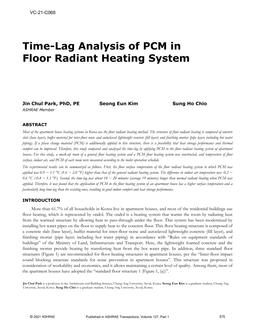
VC-21-C068 — Time-Lag Analysis of PCM in Floor Radiant Heating System
- Comments Off on VC-21-C068 — Time-Lag Analysis of PCM in Floor Radiant Heating System
- ASHRAE
Most of the apartment house heating systems in Korea use the floor radiant heating method. The structure of floor radiant heating is composed of concrete slab (base layer), buffer material for inter-floor noise and autoclaved lightweight concrete (fill layer) and finishing mortar (pipe layer; including hot water piping). If a phase change material (PCM) is additionally applied to this structure, there is a possibility that heat storage performance and thermal comfort can be improved. Therefore, this study compared and analyzed the time-lag by applying PCM to the floor radiant heating system of apartment houses. For this study, a mock-up room of a general floor heating system and a PCM floor heating system was constructed, and temperature of floor surface, indoor air, and PCM of each room were measured according to the boiler operation schedule.
The experimental results can be summarized as follows. First, the floor surface temperature of the floor radiant heating system to which PCM was applied was 0.9 ~ 1.1 °C (1.6 ~ 2.0 °F) higher than that of the general radiant heating system. The difference in indoor air temperature was -0.2 ~ 0.6 °C (-0.4 ~ 1.1 °F). Second, the time-lag was about 18 ~ 20 minutes (average 19 minutes) longer than normal radiant heating when PCM was applied. Therefore, it was found that the application of PCM to the floor heating system of an apartment house has a higher surface temperature and a particularly long time-lag than the existing ones, resulting in good indoor comfort and heat storage performance.
Citation: 2021 Virtual Conference Papers
Product Details
- Published:
- 2021
- Number of Pages:
- 6
- Units of Measure:
- Dual
- File Size:
- 1 file , 1.7 MB
- Product Code(s):
- D-VC-21-C068

